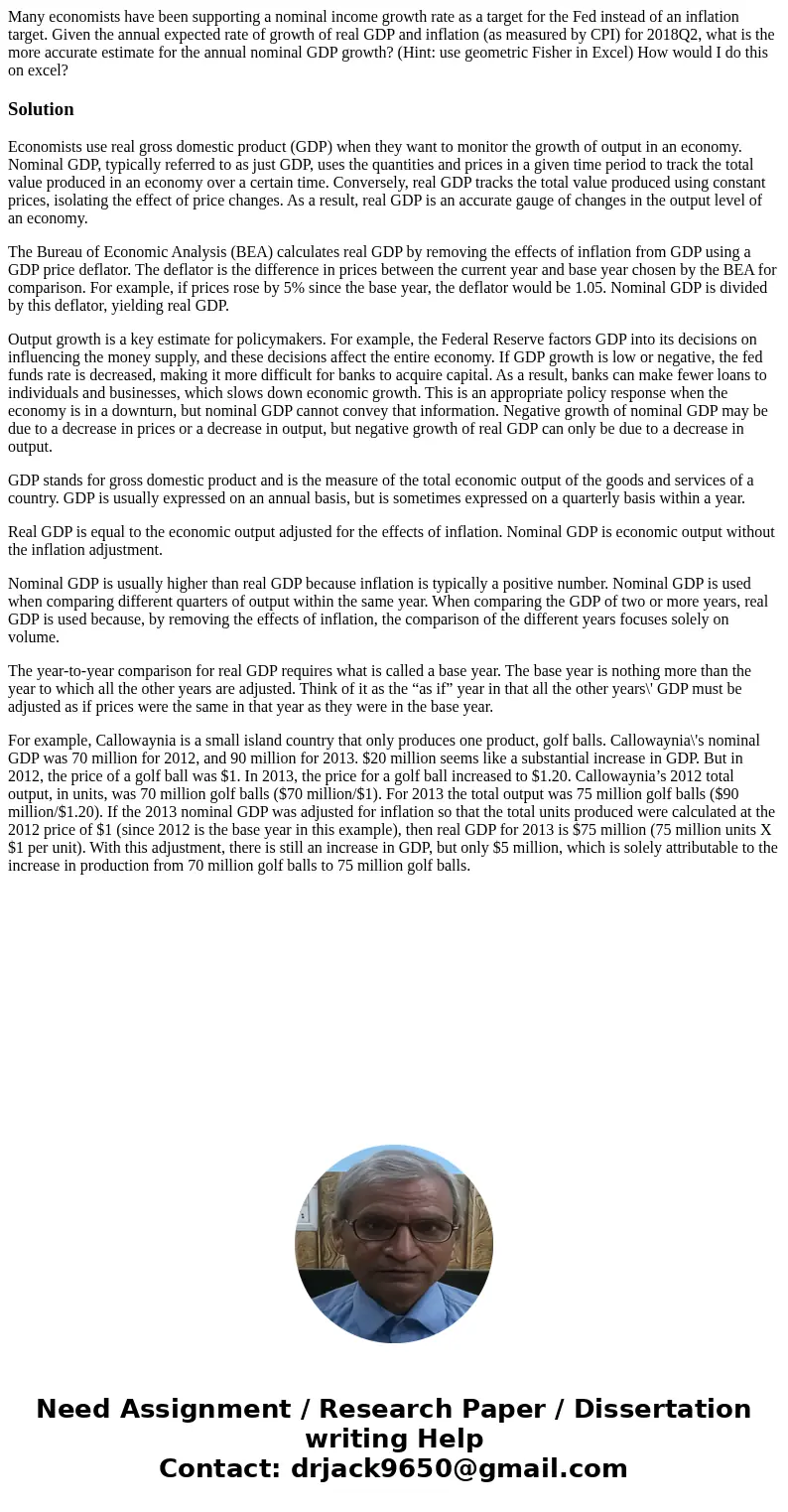Many economists have been supporting a nominal income growth
Many economists have been supporting a nominal income growth rate as a target for the Fed instead of an inflation target. Given the annual expected rate of growth of real GDP and inflation (as measured by CPI) for 2018Q2, what is the more accurate estimate for the annual nominal GDP growth? (Hint: use geometric Fisher in Excel) How would I do this on excel?
Solution
Economists use real gross domestic product (GDP) when they want to monitor the growth of output in an economy. Nominal GDP, typically referred to as just GDP, uses the quantities and prices in a given time period to track the total value produced in an economy over a certain time. Conversely, real GDP tracks the total value produced using constant prices, isolating the effect of price changes. As a result, real GDP is an accurate gauge of changes in the output level of an economy.
The Bureau of Economic Analysis (BEA) calculates real GDP by removing the effects of inflation from GDP using a GDP price deflator. The deflator is the difference in prices between the current year and base year chosen by the BEA for comparison. For example, if prices rose by 5% since the base year, the deflator would be 1.05. Nominal GDP is divided by this deflator, yielding real GDP.
Output growth is a key estimate for policymakers. For example, the Federal Reserve factors GDP into its decisions on influencing the money supply, and these decisions affect the entire economy. If GDP growth is low or negative, the fed funds rate is decreased, making it more difficult for banks to acquire capital. As a result, banks can make fewer loans to individuals and businesses, which slows down economic growth. This is an appropriate policy response when the economy is in a downturn, but nominal GDP cannot convey that information. Negative growth of nominal GDP may be due to a decrease in prices or a decrease in output, but negative growth of real GDP can only be due to a decrease in output.
GDP stands for gross domestic product and is the measure of the total economic output of the goods and services of a country. GDP is usually expressed on an annual basis, but is sometimes expressed on a quarterly basis within a year.
Real GDP is equal to the economic output adjusted for the effects of inflation. Nominal GDP is economic output without the inflation adjustment.
Nominal GDP is usually higher than real GDP because inflation is typically a positive number. Nominal GDP is used when comparing different quarters of output within the same year. When comparing the GDP of two or more years, real GDP is used because, by removing the effects of inflation, the comparison of the different years focuses solely on volume.
The year-to-year comparison for real GDP requires what is called a base year. The base year is nothing more than the year to which all the other years are adjusted. Think of it as the “as if” year in that all the other years\' GDP must be adjusted as if prices were the same in that year as they were in the base year.
For example, Callowaynia is a small island country that only produces one product, golf balls. Callowaynia\'s nominal GDP was 70 million for 2012, and 90 million for 2013. $20 million seems like a substantial increase in GDP. But in 2012, the price of a golf ball was $1. In 2013, the price for a golf ball increased to $1.20. Callowaynia’s 2012 total output, in units, was 70 million golf balls ($70 million/$1). For 2013 the total output was 75 million golf balls ($90 million/$1.20). If the 2013 nominal GDP was adjusted for inflation so that the total units produced were calculated at the 2012 price of $1 (since 2012 is the base year in this example), then real GDP for 2013 is $75 million (75 million units X $1 per unit). With this adjustment, there is still an increase in GDP, but only $5 million, which is solely attributable to the increase in production from 70 million golf balls to 75 million golf balls.

 Homework Sourse
Homework Sourse